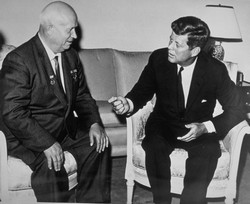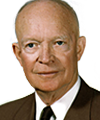Cold War In The Us
|
| updated |
Copy Link Code
|
 The Cold War resulted from political and military differences between the Western Bloc and Eastern Bloc following World War II. The United States, along with NATO Allies dominated the Western Bloc, while Russia and members of the Warsaw Pact controlled the Eastern Bloc. Once the alliance against Nazi Germany had been formed, the United States and Russia rose to be superpowers. The term, Cold War, refers to psychological warfare between these two superpowers wherein one or both would engage in proxy wars, which is a conflict through a third country, but never directly with each other. One example of a proxy war was the Korean War, which split the country into North Korea governed by communism and South Korea, which was non-communistic. Through propaganda, Russia was spreading communism quickly through covert operations, infiltration and the distribution of false information. It was in this political environment that Dwight Eisenhower assumed the U.S. presidency in 1953.
The Cold War resulted from political and military differences between the Western Bloc and Eastern Bloc following World War II. The United States, along with NATO Allies dominated the Western Bloc, while Russia and members of the Warsaw Pact controlled the Eastern Bloc. Once the alliance against Nazi Germany had been formed, the United States and Russia rose to be superpowers. The term, Cold War, refers to psychological warfare between these two superpowers wherein one or both would engage in proxy wars, which is a conflict through a third country, but never directly with each other. One example of a proxy war was the Korean War, which split the country into North Korea governed by communism and South Korea, which was non-communistic. Through propaganda, Russia was spreading communism quickly through covert operations, infiltration and the distribution of false information. It was in this political environment that Dwight Eisenhower assumed the U.S. presidency in 1953.
The Dwight Eisenhower Cold War period addressed communism through containment, a U.S. policy to prevent communism from spreading internationally, but mainly abroad. Eisenhower favored relying on the threat of nuclear war against Russia rather than provoking a conflict that might lead to World War III. To this end, Eisenhower ordered an increase in the number of nuclear weapons in America's arsenal from a thousand war-heads in 1953 to eighteen thousand warheads in 1961. Although he knew that the Soviet Union had nuclear bombs, he felt that the superiority of the U.S. arsenal was the right deterrent for communism. Eisenhower further believed that making the nuclear warheads a weapon of first resort, the Cold War would continue more as psychological warfare than to becoming a military conflict. Eisenhower's Cold War approach was also much cheaper, offering the American taxpayer more "bang for the buck."
In 1955, the first 3-52 Stratofortress bomber, the first jet bomber specifically designed to transport nuclear weaponry, was developed. It was another looming threat to Russia. Eisenhower continued to build up the U.S. threat under his containment policies, situating intermediate range missiles in Turkey, which were aimed at the cities of western U.S.S.R., which included Moscow, which was only sixteen minutes away for one of these missiles. There were also submarines that could launce Polaris missiles directed at Russia within minutes of an order. Eisenhower's Cold War strategies worked, eventually overpowering the capabilities of the Western Bloc should another attempt at an international conflict arise or if the Western Bloc tried to overpower another country.
During the period of the Cold War, Eisenhower rejected several suggestions that he use nuclear weapons in several countries where communism was being forced, such as Indochina and Taiwan. When called upon, Eisenhower addressed the Cold War with diplomacy under the threat of using nuclear force. He always optioned for a peaceful outcome to military conflicts through armistices and treaties, such as those that ended the Korean War. He also "waged peace" by trying to negotiate a treaty that would ban nuclear testing in the air and on the sea, but the Soviet's shot down the U-2 reconnaissance plane belonging to the U.S., which essentially ended any hopes for such a treaty during Eisenhower's presidency.
